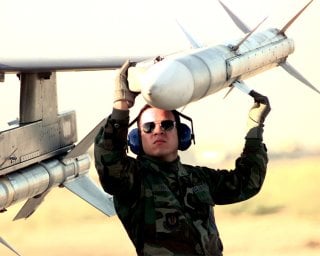The AIM-120 AMRAAM Missile, Explained
With air combat to be key in a potential conflict with China or Russia, the U.S. military is investing heavily in new platforms and munitions, such as the AIM-120 AMRAAM.
In addition to new weapons, the U.S. military has a large stock of capable and reliable munitions. Indeed, if there is a staple in the U.S. tactical air forces’ arsenal, it is the AIM-120 Advanced Medium Range Air-to-Air Missile (AMRAAM). The munition can defeat adversaries at very long distances without even being in direct visual contact.
The AIM-120 AMRAAM
The AIM-120 AMRAAM is an all-weather, radar-homing guided air-to-air missile. The munition has dual capability and can strike targets within visual range and beyond visual range. Another capability of the AIM-120 is its ability for several missiles to engage several different targets at the same time, allowing one fighter jet armed with several AIM-120 AMRAAMs to wreak havoc on an enemy formation.
What makes the AIM-120 AMRAAM very effective is the fact that it is a beyond-visual-range munition, meaning that it can engage targets at ranges beyond the visual range. Indeed, the latest version of the AIM-120 has a range of over 100 miles.
“AMRAAM is a follow-on to the AIM-7 Sparrow missile series. The missile is faster, smaller, and lighter, and has improved capabilities against low-altitude targets. It incorporates active radar with an inertial reference unit and micro-computer system, which makes the missile less dependent upon the fire-control system of the aircraft,” the Air Force states about the AIM-120.
When the AIM-120 gets close to an enemy aircraft, its onboard active radar guides it to the target.
“This enables the pilot to aim and fire several missiles simultaneously at multiple targets. The pilot may then perform evasive maneuvers while the missiles guide themselves to their targets,” the Air Force adds.
A special capability of the munition is to target jamming sources. The AIM-120 packs technology that allows it to switch from homing on radars to homing on jamming signals that try to distract it.
The AIM-120 AMRAAM can be outfitted to all of the fighter aircraft in the U.S. military and is one of the main tools in air combat alongside the AIM-9X Sidewinder, which is a heat-seeking munition.
The latest version of the air-to-air munition is the “C7,” and it sports a better antenna, signal processor, and receiver, as well as improved software that can process several different threats at the same time.
Air combat would be a key aspect of a near-peer conflict between the U.S. and China or Russia. Whoever controls the skies will control the ground and naval action. The U.S. military has thousands of aircraft ready to fight for air superiority, and munitions like the AIM-120 AMRAAM and AIM-9X Sidewinder are the right tools for these aircraft to go to war with.
The AIM-120 first entered service in 1991, and each missile costs approximately $385,000. The radar-homing munition has seen combat multiple times and several “kills” under its belt. In addition to the U.S. military, the AIM-120 AMRAAM is in service with dozens of friendly countries around the world.
Stavros Atlamazoglou is a seasoned defense journalist specializing in special operations and a Hellenic Army veteran (national service with the 575th Marine Battalion and Army HQ). He holds a BA from Johns Hopkins University and an MA from the Johns Hopkins School of Advanced International Studies (SAIS). His work has been featured in Business Insider, Sandboxx, and SOFREP.
Image Credit: Creative Commons and/or Shutterstock.

